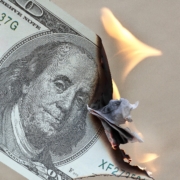The Palms Conundrum
What is Station Casinos doing with Palms?
That’s a question that should be on investors’ minds since the company has committed nearly half a billion dollars to the latest addition to its portfolio of casinos in Las Vegas. Adding $146 million of renovation cost to the $312.5-milion purchase price brings the total capex on Palms to $452.5 million. As explained by CFO Stephen Cootey, the company’s “expected returns” on “any capital expenditures” are in the “mid to low teens” range. This would suggest that, in a best-case scenario, investors might see Palms’ making annual EBITDA of close to $70 million (425.5 x 15% = 67.9) after the renovation is done by the end of second quarter next year. This is a much more ambitious target than the $35 million the company originally put forth when it announced the acquisition. (We raised some questions about that projection previously, given our estimate that Palms’ LTM EBITDA was approximately $28 million at the time.) So how will Station Casinos get there?
Palms is not a typical Station Casinos property
A major challenge facing Station Casinos is the fact that Palms is a very different kind of property from what the company is used to operating. Even though Palms was described as a “leading gaming asset” by Station management, it did not generate most of its revenues from gaming. In fact, the casino department contributed only approximately 37% of its property-level gross revenue during the fourth quarter of last year, according to Red Rock Resorts’ 10-K. Even assuming there was some disruption due to the change in ownership and management, that figure shows Palms is a very different breed of casino resort than other Station properties.
| (In $ millions) | 4Q16 | % of Total |
| Casino revenues (reported) | 15.5 | 37.0% |
| F&B revenues (reported) | 8.7 | 20.8% |
| Rooms revenues (reported) | 11.6 | 27.7% |
| Other revenues (estimated) | 6.0 | 14.5% |
| Gross revenues (estimated)* | 41.8 |
* Red Rock reported the net revenues were $38.5 million at Palms in 4Q16. Assuming promotional allowances of 8% of gross revenues, we calculated the gross revenues to be $41.8 million.
In fact, Palms seems to be very similar to a Strip resort in terms of its revenue mix. Here’s the revenue breakdown of major Strip properties last year, according to the most recent Nevada Gaming Abstract.
| (in $ millions) | FY2016 | % of Total |
| Casino | 5,396 | 34.1% |
| Rooms | 4,419 | 28.0% |
| Food | 2,527 | 16.0% |
| Beverage | 1,126 | 7.1% |
| Other | 2,335 | 14.8% |
| Total | 15,805 |
This is not how Station Casinos has run its business. Before Palms, Station Casinos properties had always generated most of their revenues from the casino floor. Back in 2006, gaming made up anywhere from just under two thirds to over 80% of gross revenues at the company’s “large properties” in Las Vegas (according to a report filed during the Station Casinos Chapter 11 case).
| (In $ millions) | Gross Revenues | Gaming Revenues | Gaming as % of Gross |
| Palace Station | 176.1 | 126.0 | 71.6% |
| Boulder Station | 216.9 | 174.7 | 80.5% |
| Texas Station | 143.3 | 107.9 | 75.3% |
| Sunset Station | 222.9 | 168.0 | 75.4% |
| Santa Fe Station | 184.1 | 150.3 | 81.6% |
| Green Valley | 297.9 | 202.9 | 68.1% |
| Fiesta Rancho | 73.2 | 58.0 | 79.3% |
| Fiesta Henderson | 83.9 | 61.0 | 72.7% |
| Red Rock (Opened 4/18/06) | 250.3 | 158.8 | 63.4% |
| Total | 1,648.6 | 1,207.6 | 73.2% |
This heavy reliance on gaming was true of even Green Valley Ranch (which had been open for five years) and Red Rock Station (which had been open for less than a year). It is true that these “hybrid” properties, which according to the company “appeal to both Las Vegas residents and tourists”, have a greater non-gaming side to their operations, but they still seem to be very different than Palms.
And we do not believe the revenue mix has changed significantly at GVR and Red Rock, since the most recent pre-Palms financial disclosures continued to show the overweighting of casino revenue in its Las Vegas properties. In the first nine months of 2016, Station Casinos earned approximately 67% of its gross revenues from gaming at its Las Vegas properties (i.e., company-wide gross revenues excluding management fees revenues).
| (In $ millions) | 9M16 | % of Gross |
| Casino revenues | 706.2 | 67.0% |
| F&B revenues | 196.6 | 18.6% |
| Rooms revenues | 99.6 | 9.4% |
| Other revenues | 52.4 | 5.0% |
| Gross revenues | 1,054.6 |
What kind of management experience can a company like this bring to Palms? Does Station Casinos have the management know-how to operate an almost-Strip property like Palms?
Will casino revenue at a “Stationized” Palms go from one-third of total revenue to two-thirds of the total? If that is indeed the goal, then presumably the strategy is to grow gaming revenue at Palms and not to shrink the non-gaming business there. How would then Station Casinos go about doing that?
Management instability
Whatever the strategy there is for growing revenue (and EBITDA) at Palms, why is Station Casinos already onto its third general manager at the property in less than a year’s time?
When Stations Casinos officially took over last year, Michael Jerlecki, formerly the general manager of Palace Station, which is not one of the company’s “luxury” properties, was made the new Palms general manager. By January 2017, Jerlecki was quietly replaced by Anthony Faranca (according to Faranca’s LinkedIn page), who had been general manager of the Parx racino outside Philadelphia, a change the company didn’t officially announced until April. Then, in July a local magazine profiled new Palms executive Jon Gray and described him as the property’s general manager, in spite of any formal announcement from the company. (Gray did sign as the general manager letters informing workers of their termination due to the closing of several F&B venues at Palms in early September.)
The hiring of Gray was something of a homecoming, for he was an executive at the Palms when it was still owned by the Maloofs and was general manager of N9Ne Group heading up the hotel’s nightclubs, restaurants, and pool events at the property. He also opened the non-gaming F&B/entertainment LINQ District on the Strip and worked for Nike in Oregon before returning to Palms. What is missing from this impressive resume, though, is any significant experience with casino operations.
Assuming he lasts longer than his two predecessors as Palms’ general manager, is Jon Gray the right person to “Stationize” and grow casino revenue at Palms?









